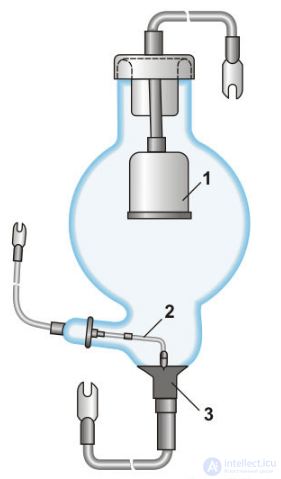Lecture

The ignitron device: (1) Anode, (2) Cathode, (3) Igniting electrode, (4) Mercury, (5) Insulators, (6) Coolant
Mercury rectifier , ignitron (from the Latin. Ignis - fire and electron ) - single-electrode ion device with a mercury cathode and controlled arc discharge. It is used as a mercury electric valve in high-power rectifier devices, electric drives, electric welding devices, traction and rectifying substations, etc. [1] . with an average current of hundreds of amps and a rectified voltage of up to 5 kV [2] .
The ignitron is characterized by an insignificant voltage drop (15–20 V) and high efficiency (98–99%) [2] .
The emission of electrons, causing the main arc discharge between the anode and the cathode, occurs at a positive anode voltage from one or more brightly lit areas of the cathode (cathode spots). Cathode spots are created by an auxiliary arc, which is formed periodically before ignition of the main arc by passing current pulses with an amplitude of up to several tens of amperes and a few milliseconds in duration through a boron carbide igniting electrode [2] partially immersed in liquid mercury of the cathode. By changing the moment of ignition of the auxiliary arc, it is possible to control the start of ignition of the main arc and thereby regulate the average value of the strength of the rectified anode current from maximum to zero.
Comments
To leave a comment
Radio tubes and ion devices
Terms: Radio tubes and ion devices